The second Champions League semi-final will take place on Wednesday night, with Lyon taking on Bayern Munich. Both sides come into the game off the back of real statement wins, with Bayern Munich’s infamous thrashing of Barcelona last week followed by a shock Lyon win against Manchester City. The actual structure of the game seems fairly predictable when watching the two sides games this season. Ligue 1 side Lyon will likely set out with the same game plan that has allowed them to frustrate Manchester City and Juventus, while Bayern Munich will go back to their possession-based style of play and look to manipulate Lyon with their positional play.
With Bayern Munich favourites in the game, it begs the question of how can they break down a system that Manchester City and Juventus struggled against? In this tactical analysis, I will look to answer that question by examining how Bayern will look to structure their positional play against Lyon, while also dissecting how Lyon can attempt to limit Bayern’s tactics and play on the counter.
Principles of Bayern’s positional play
Following the results in the UEFA Champions League last week, it was interesting to see some criticisms of possession-based football, considering that Bayern Munich for the large part are a possession-based side. Of course, this doesn’t mean possession for the sake of it, but a very intense pressing system combined with aspects of positional play generally leads to high possession football, which is what Bayern have achieved with a 64% average possession this season. This section will examine the principles involved in their positional play.
This theoretical scene below highlights the main basic ideas behind Bayern’s positional play and explores the roles within it. There are six overall roles within the structure, with first being depth. With Bayern’s build-up very half-space focussed, their build-up usually involves depth in the half-space and involves a centre back having possession there. Vertically in front of the centre back, we will see a player occupying the half-space.
To open the passing lane to the half-space, central and wide pinning is needed, otherwise, the opposition second line can just close the space off easily. Here we see the full-back provides width, while the central midfielders occupy the opposition central midfielders. This opens the half-space, but often we will see one player become isolated in the area and be pressable without the right conditions around them. These conditions involve a +1 and a player that provides height. The +1 could also be called an overloader, as their role is to move into areas to create numerical superiority. Here they would move into the half-space and create a 2v1 on the opposition full-back. To prevent the opposition back-line moving forward and pressuring the half-space, height is needed at all times to offer penetration in behind and pin the defence in place.
Notice how roles have been assigned within the system, not positions. Positions, of course, exist within the system, but players can rotate between roles often, and most of the time it does not matter who occupies which role, as long as they are fulfilled. Not every positional attack can include all of these roles, and every role is not always needed, but in an ideal scene, this is what Bayern aim for.

Below we can see another basic example of their positional play, with this time a back three utilised thanks to Thiago dropping deeper. This allows for the back line to spread and increases their depth effectively, meaning the centre backs access to this deep half-space is improved. We see the full-back Alphonso Davies provides the width, while winger Ivan Perišić occupies the half-space, with striker Lewandowksi ahead of him providing height. This is the typical structure of the roles in Bayern’s side, although rotations occur as I’ve mentioned. We see not all the roles are fulfilled here, namely the +1 player, however, the structure still allows for ball progression.

I feel as though I use this scene in every analysis, but it is just so good that it needs including here too. It encapsulates perfectly the principles in Bayern’s play and also highlights the idea of roles over positions. We see Leon Goretzka drops deeper to receive, while right full-back Benjamin Pavard then moves into the half-space. Because of this movement by Pavard, Gnabry recognises the need to provide width, and so he moves wide and deeper to receive.

The dropping movement by Goretzka draws his marker higher up the pitch, and out of the half-space, and so when the ball is played wide, Pavard is able to receive in the space left in the half-space by the pressing midfielder. It shows a clear understanding of roles within a system when players can rotate and be creative within the rules of the structure, and it also benefits them offensively in confusing or dismarking opponents. In terms of getting set in an offensive structure, having an understanding of what roles need fulfilling is vital, as players can then quickly decide on what movement needs to be made.

In this example, we see Thomas Müller, who usually is in that Raumdeuter or overloading +1 role, in the half-space acting as an inside forward within a 4-3-3. Pavard provides the width, while Müller’s movement in behind also allows him to act as the height provider in the team. As a result, we see a Bayern midfielder move forward into the half-space also to become that overloader.
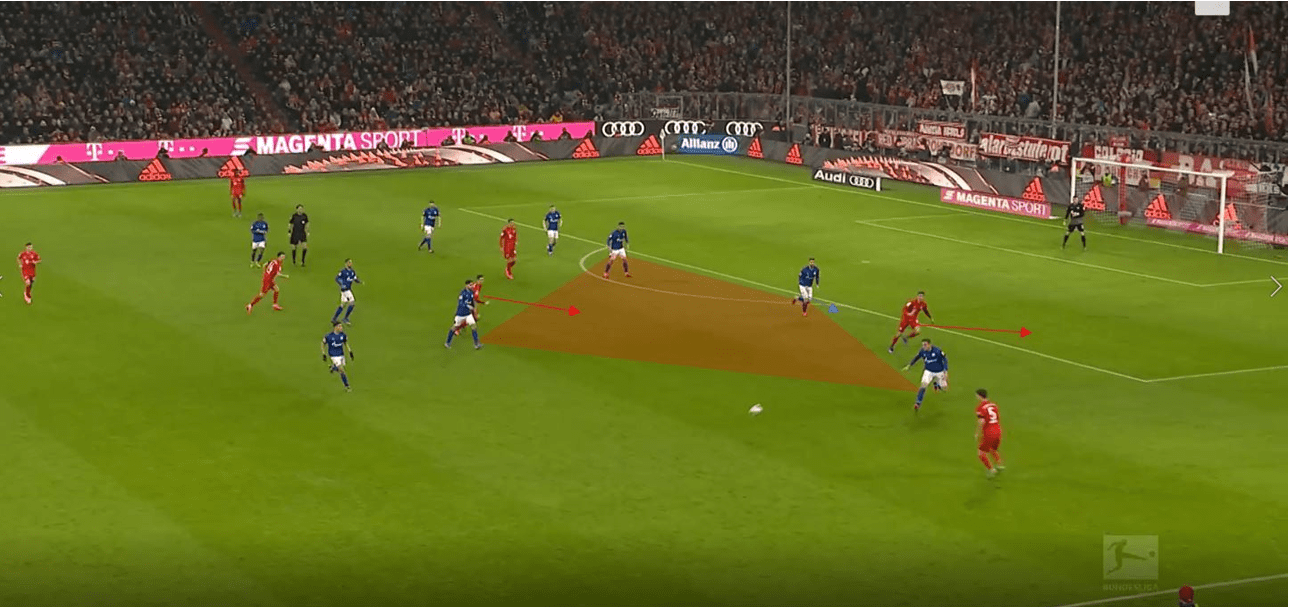
We see here with Bayern back in their 4-2-3-1 shape, Müller becomes that +1 player again, staying just behind Chelsea’s second line before then moving forward to receive. Kinglsey Coman pushes higher into the half-space, while Robert Lewandowski is also high on Chelsea’s defensive line, which helps pin Chelsea in place and stops them closing Müller’s space. Bayern have again dropped into a back three as they do often, with Kimmich here allowing Pavard to push higher.
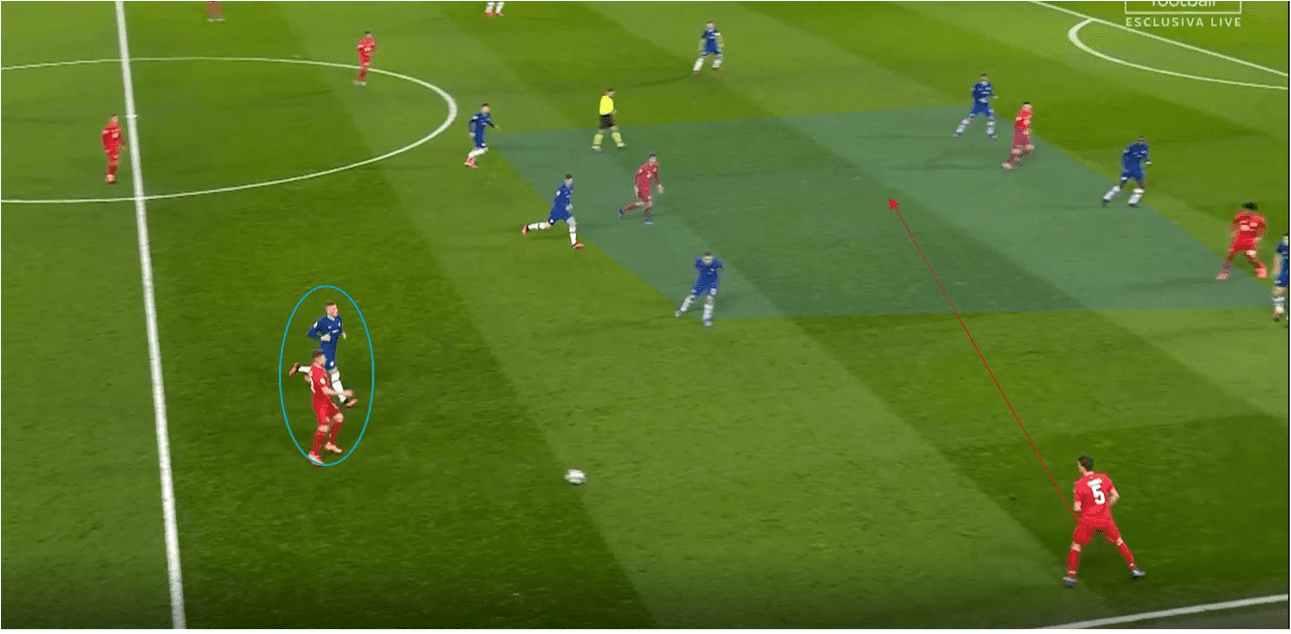
This final example shows the interaction between Müller and Lewandowski and the roles they play. We see Lewandowski drops vertically ahead of the wide centre back, while the width is provided by the full-back. Müller is drifting in towards the half-space, while Kinglsey Coman moves high and wider. The ball is then played out to Pavard.
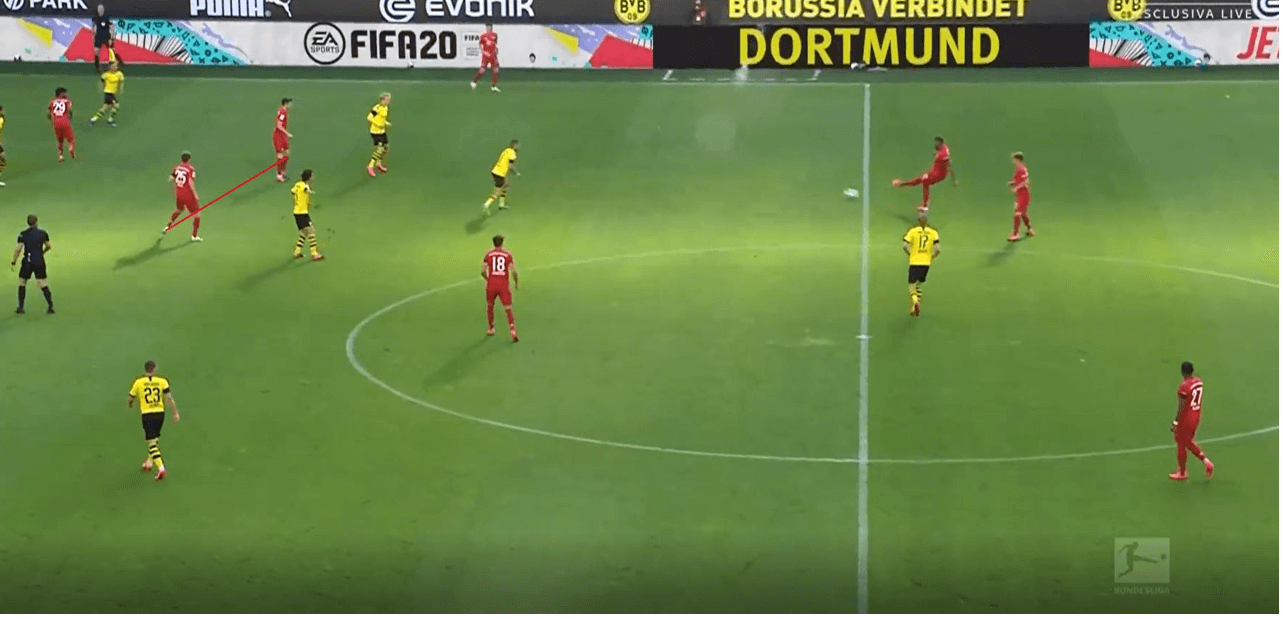
Müller then gets into a higher position in the half-space to receive, while Lewandowski then runs from a deeper area to arrive into space. This means that he is immediately facing forward when he receives the ball, and Kinglsey Coman’s wide positioning helps to keep the opposition defender wide and increases Lewandowski’s space. This double width from Bayern is sometimes needed to penetrate, and so dynamic space occupation and body orientation can be used as a substitute for height.
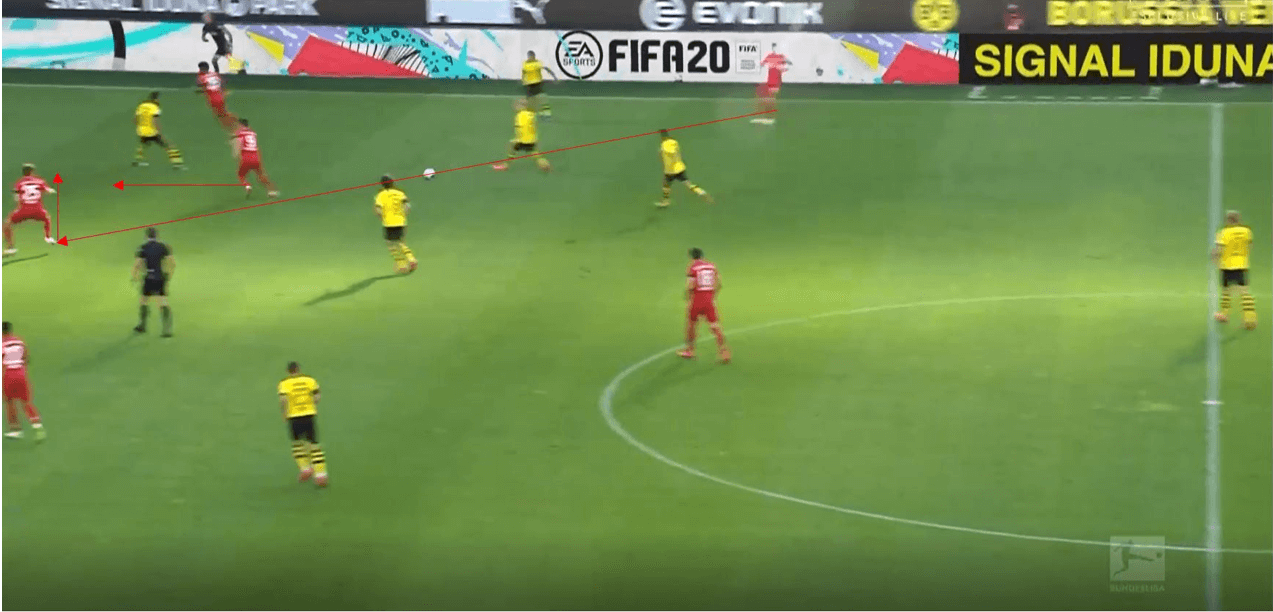
Lyon’s 5-3-2 vs. a back four
The most likely shape we will see Lyon in for the game will be their preferred 5-3-2, which they used in their games against Manchester City and Juventus. This system can be seen outlined below in its basic structure, and this section will explore the core principles within this structure.
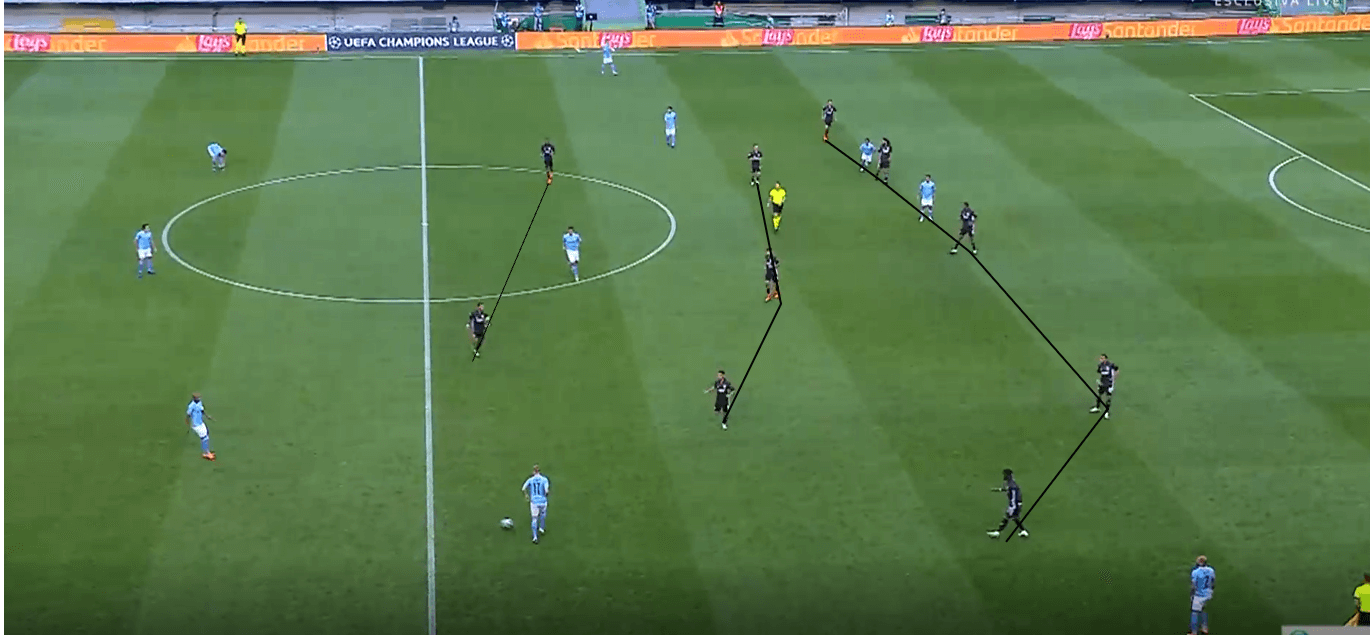
We will first start with how this press interacts with a back four, with the Juventus match giving us a good example of this. Lyon play a fairly passive style out of possession and generally won’t press until near the halfway line, but the strikers are by no means lazy and work hard throughout the game. As you would expect, the opposition centre backs are pressed by the strikers, but the strikers also look to cut access to the pivot, either by blocking the passing lane as Memphis Depay does here or by man-marking them when the other striker is pressing.
The widest central midfielder of the three will push wide and press the full-back when they receive, while pressure on the half-space is applied by the wide central defenders, who behave in a very man orientated fashion, pressing high and staying tight to players in the half-space looking to receive.
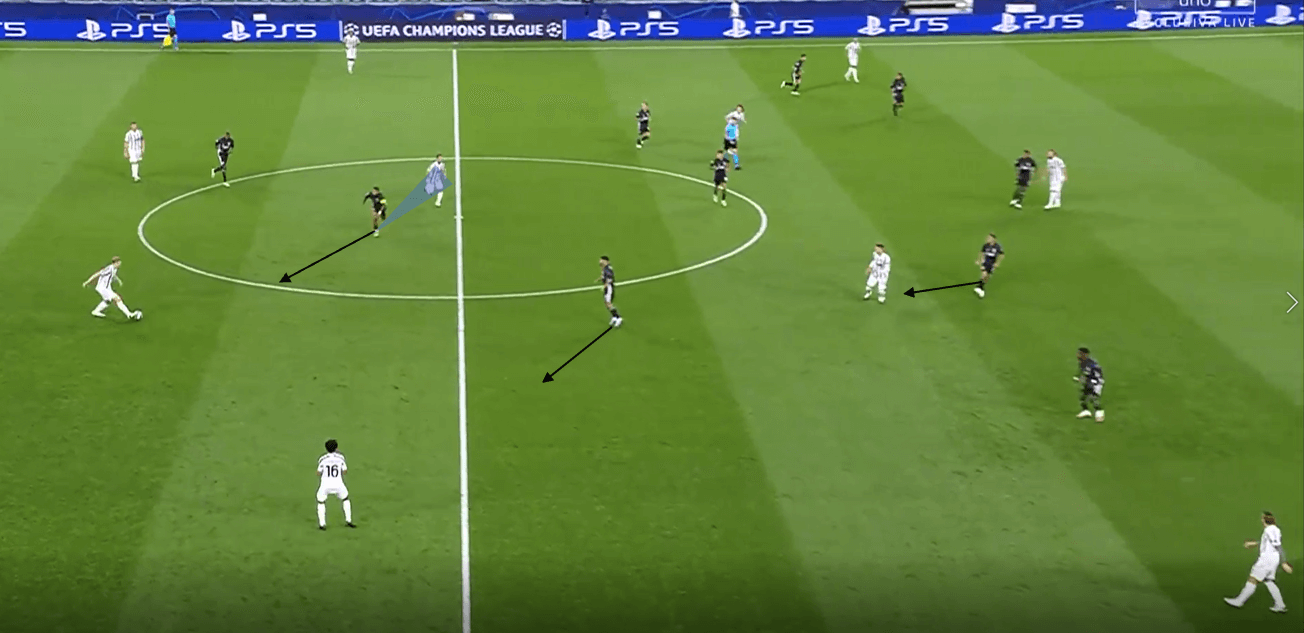
We can see here when the ball is forced wide to a full-back, Lyon’s central midfielder presses wide while the rest of the midfield shuffles across. The strikers try to cut access to the pivot as much as possible, with Ekambi here working back to prevent the pivot receiving. This helps to prevent the midfield from having to press too high and become unbalanced. As we will come onto though, with constant and sharp switching of play, this can be caught out.
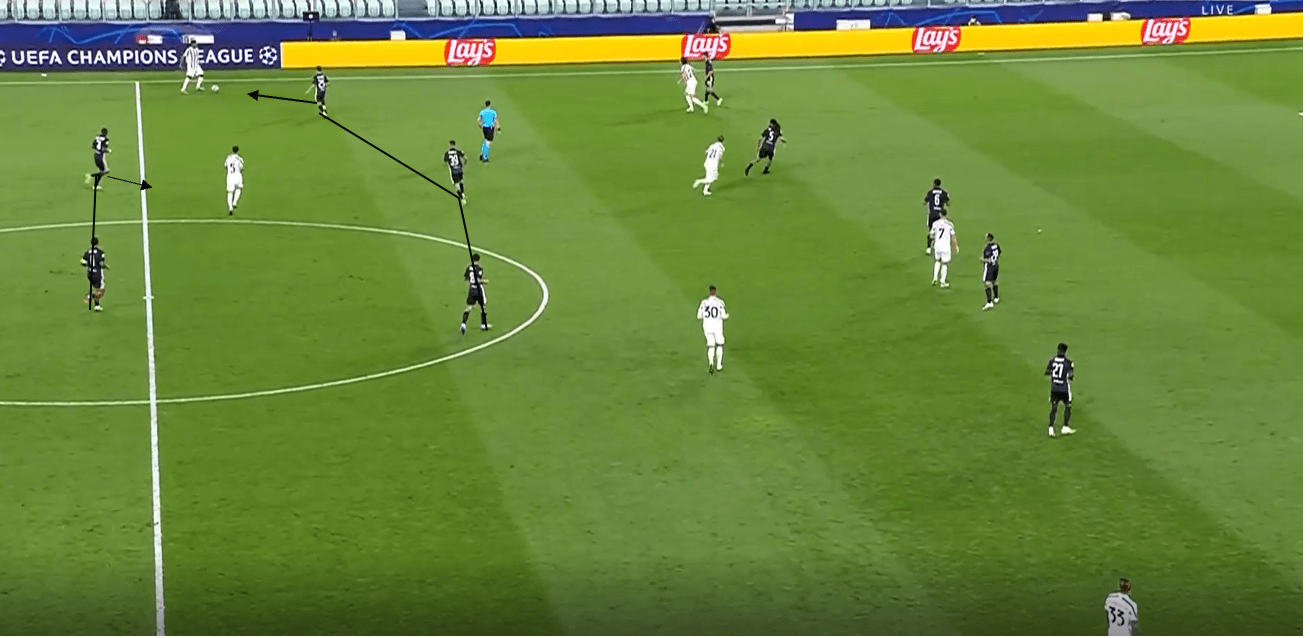
We can see here again in a deeper area that same pressing structure with the central midfielder pressing the high full-back. Memphis Depay here has dropped with the pivot and tracked back to cut access here, and as a result this forces Juventus to go back, giving Lyon the chance to reset and push higher again.
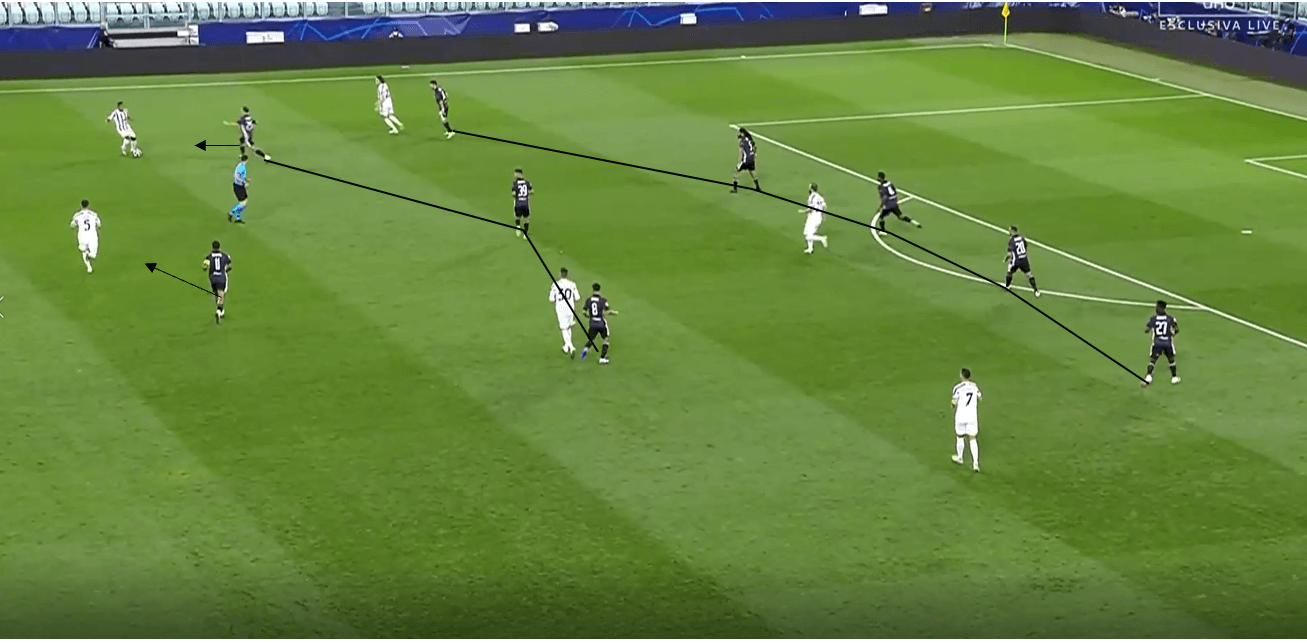
Relying on central midfielders to press wide areas can be tricky at times, especially in a midfield three, and so if the opposition can switch play frequently enough, they can alter Lyon’s press. We see here Juventus do a good job of switching the play, and due to the positioning of the central midfielder, the wing-back jumps to press Juventus’ full-back. This now leaves Juventus’ winger free, forcing the wide central defender to push across. This, in turn, increases the spacing between the right centre back and central defender, meaning a run in behind can be made.
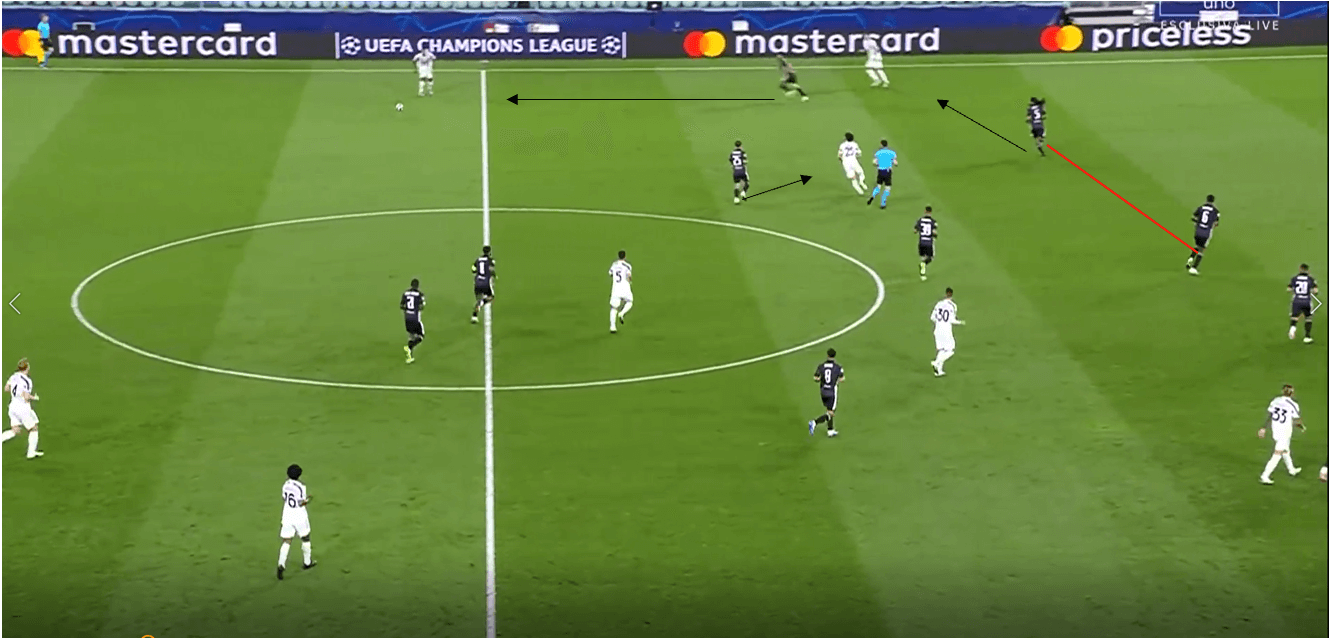
Furthermore, if you can switch play often enough and your pivot can anticipate and move to receive, you can escape the attention of the strikers at times, as we see below. These long runs from side to side are tiring for a striker and certainly, over time you can start to find the pivot if you can switch play effectively.
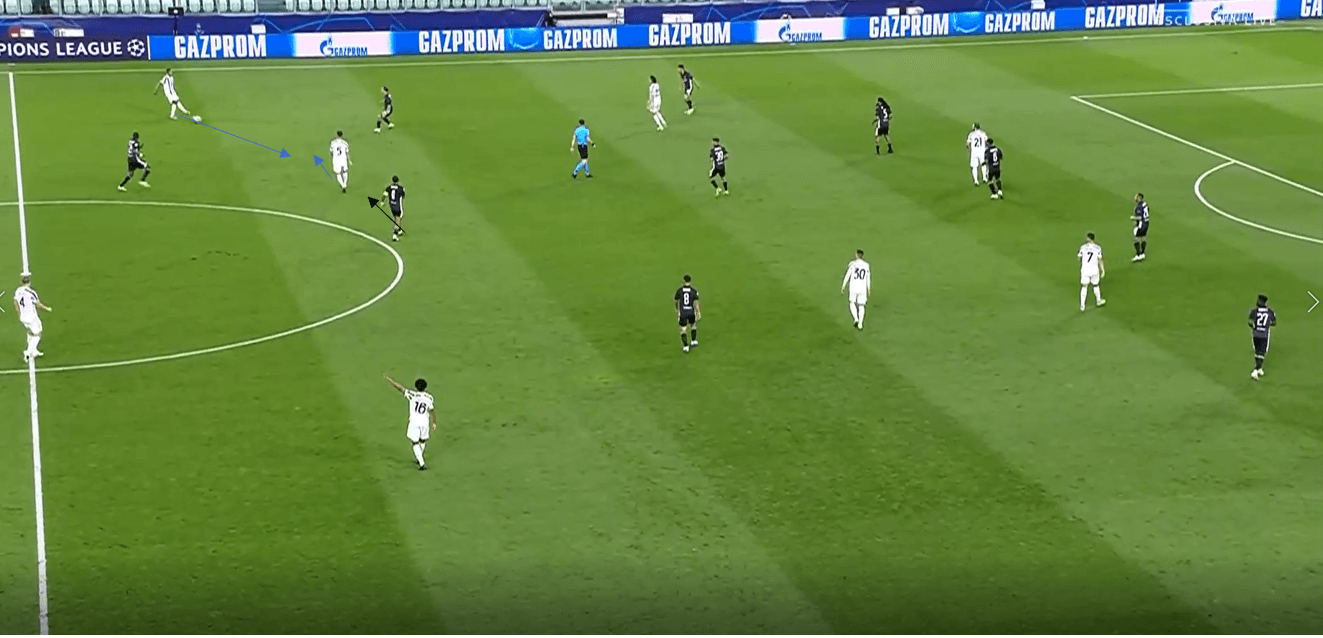
My previous preview and collection of Bayern Munich articles give a more detailed look at the deeper aspect of their build-up, and the role of their central midfielders in a double pivot.
Lyon’s 5-3-2 versus a back three
Because Bayern Munich fluctuate between a back four and back three in-game, it is important to look at the dynamics involved in their pressing against a back three, with the Manchester City game giving us good examples of this.
The pressing actions of players within this press generally depend on the height of play and the actions of other players, but we can still see the principles behind the press. Again, the press is fairly passive up until the halfway line and is generally triggered by a sideways pass to a wide centre back, or by the opposition being in a position to progress the ball.
With an extra player in the back-line, Lyon central midfielders now have to make a decision between pressing the wing-back or the wide centre back, as at times it difficult for a front two to press against three defenders. The reality is that in higher areas, the central midfielders will sit deeper and allow the wide centre back possession while protecting the half-space, before then moving to press the wing-back if a pass is played. Central midfielders are reluctant to press too high and join Lyon’s first line of pressing, as it increases their pressing distance and also increases the amount of space in behind them. As a result, if a centre back receives in their own half, the central midfielder will generally leave the pressing to the first line if possible.
We can see below the wide central midfielder moves out to press Fernandinho, while Memphis Depay cuts access to the pivot again, as is done against the back four. The advantage of not pressing high with a central midfielder is that the vertical compactness of the side can be kept, and so when the midfielder presses the centre back if the ball is played wide to the wing-back, the Lyon wing-back doesn’t have to cover a large distance to press. We can see here the wing-back is in a natural position to press the wing-back of Manchester City, and so it is difficult for City to progress.
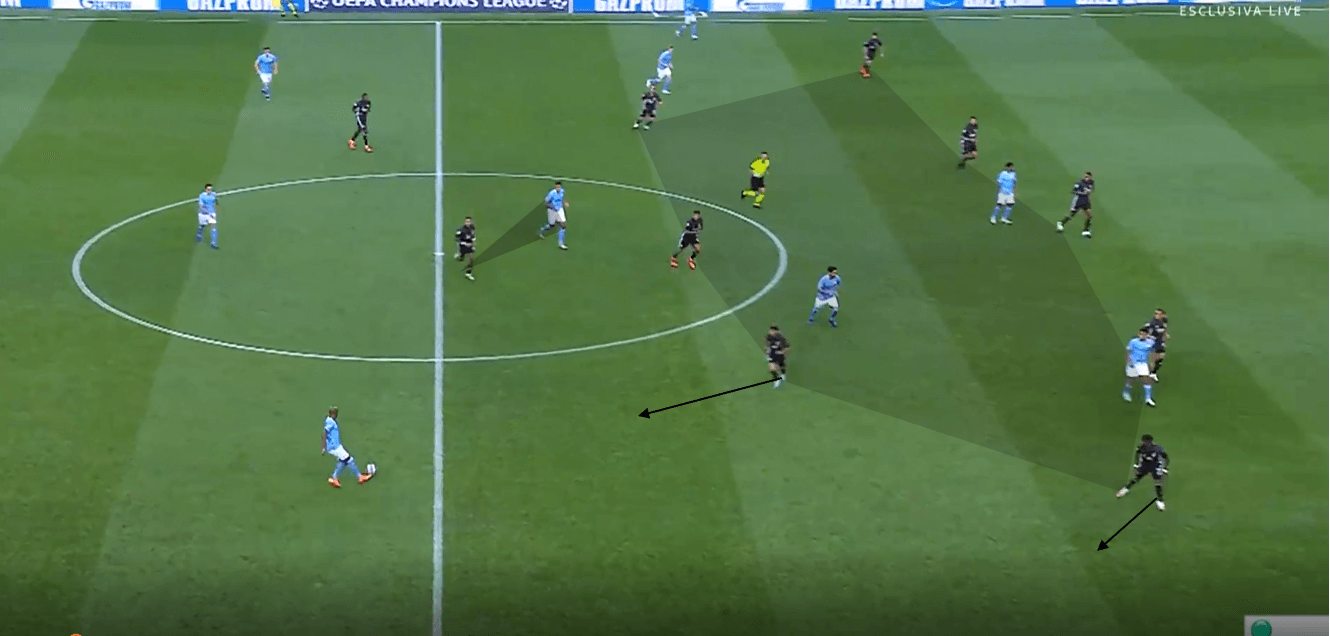
In a separate scene here, we see very similar dynamics, with this time the midfield and far striker able to close around the pivot, while the left central midfielder moves out to press Fernandinho. Wing-back Cornet moves out to press City’s wing-back, while the man orientated wide central defender follows De Bruyne deep before De Bruyne looks to make a dismarking movement to get in behind. De Bruyne’s marker Marcao was particularly aggressive in his man-marking and would follow players higher, and so this may be something to exploit for Bayern. It is also possible that Marcao deliberately stayed extra tight to De Bruyne, compared to how tight Denayer would get to someone like Sterling, as the differences in their threat in behind are obvious. This is something we will talk about a lot in the next section.
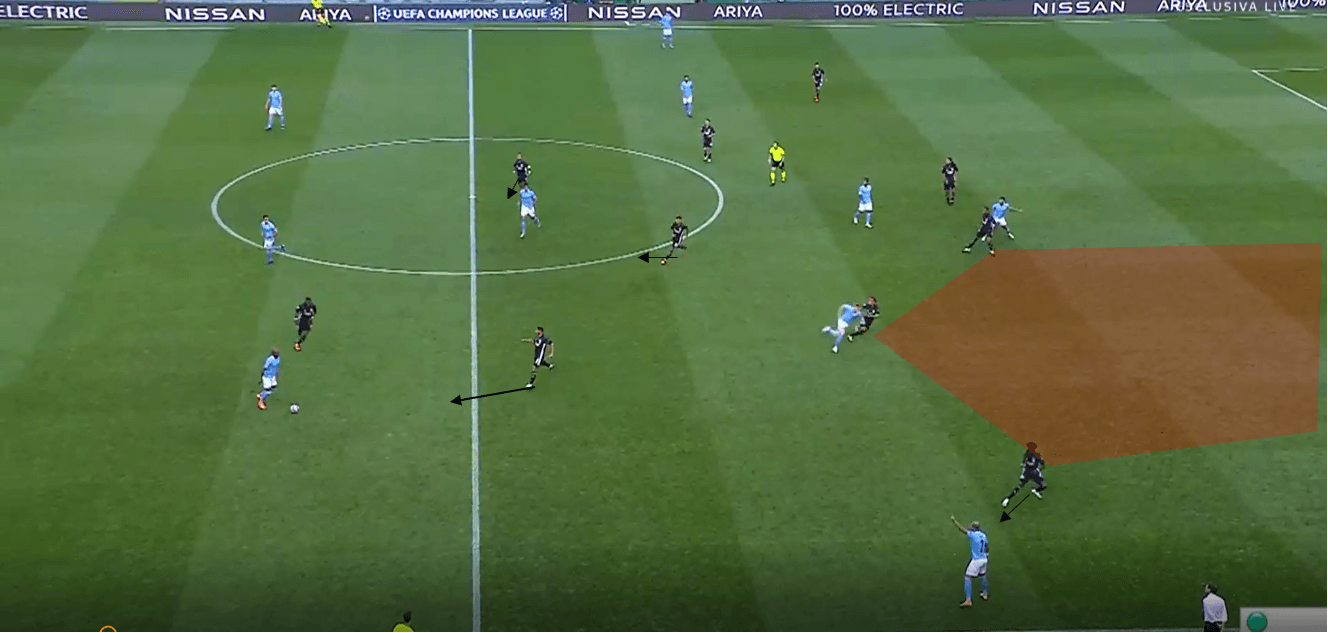
We can see a variation in Lyon’s pressing here, with City in their own half and the front two able to press the two nearest central defenders. Ekambi’s pressure on the wide centre back means the midfielder can stay deep and mark a City midfielder, and Depay again remains close to the pivot and looks to cut access to him should the ball go wide. As a result, Lyon prioritise the pivot over the other centre back, and so when City paly the ball back to the central defender, Depay can press while keeping the midfielder in his cover shadow, as previously seen.
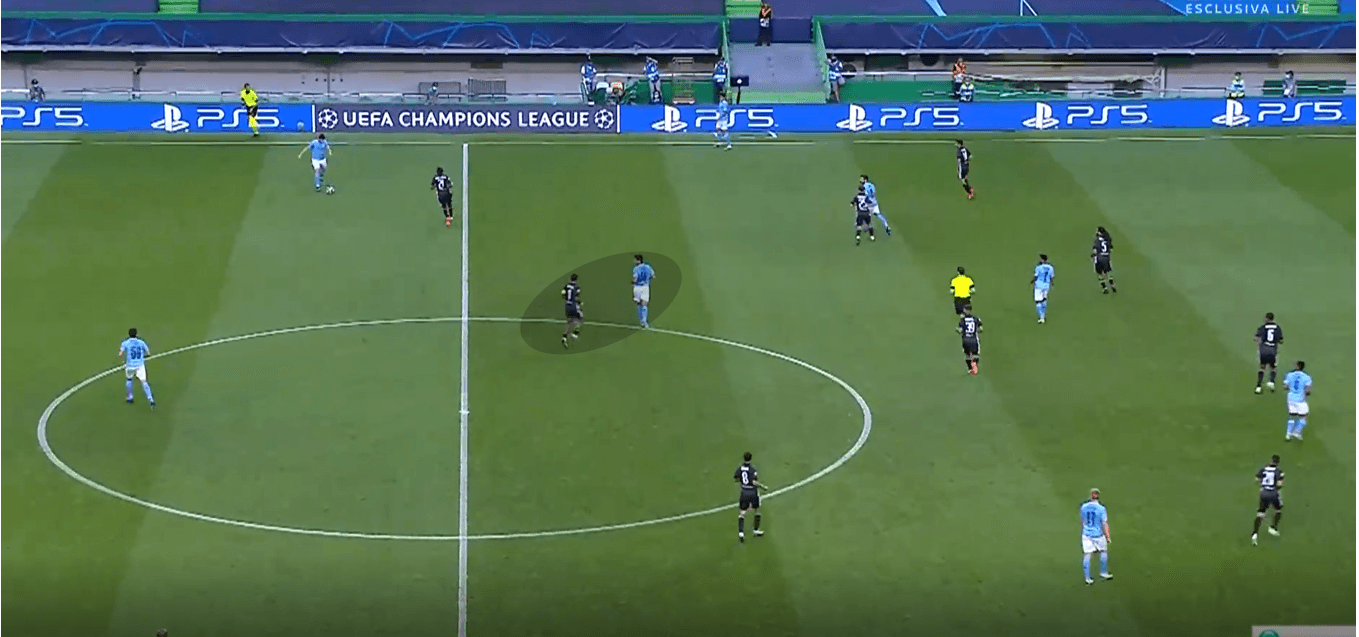
As was seen in the Juventus game, Lyon’s pressing in wide areas is not always perfect, and against a back three decisional crises can be created. We can see one such situation below, where City get the ball with their wide centre back in an advanced area. The wide central midfielder chooses not to press, and is instead distracted by the run into the half-space by a City central midfielder. Lyon’s right centre back (Denayer) has followed Sterling’s movement out, and so Gündoğan’s complementary movement forward means Denayer has to track back. As a result, Sterling then becomes the free man, and so he moves slightly higher and can receive in front of the Lyon back five, with the nearby centre backs all occupied.
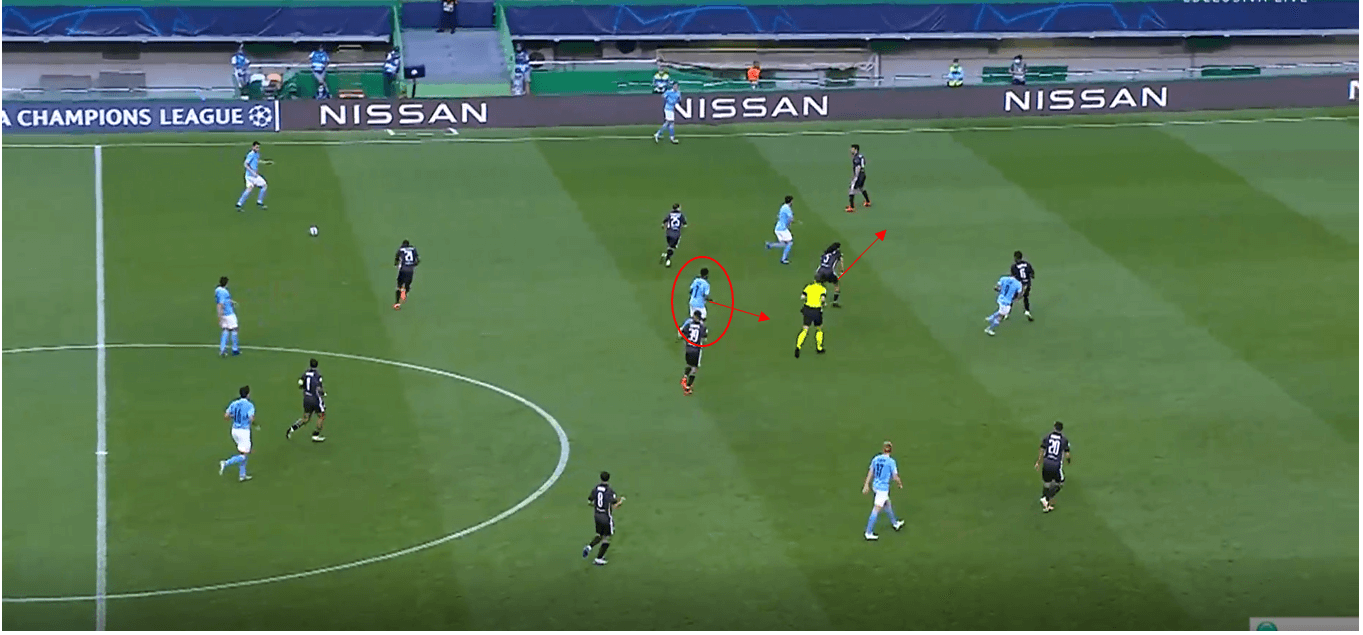
Positional play scenes vs the 3-5-2
With both systems outlined in detail, we can now look at the expected dynamics between Bayern’s positional play and Lyon’s system. As a starting point, we can see how Bayern’s most generic, basic structure would interact with Lyon’s 5-3-2. We can see they are building in a back four, with the double pivots covered by the strikers while fairly lax pressure is placed on the centre backs. The widest central midfielder covers the half-space and offers the passing lane wide to the full-back, while Bayern’s half-space occupier is marked by a Lyon centre back. One of the deciding factors in the game will be how Lyon can deal with the movement of Thomas Müller as that overloader, and whether he can coordinate movements with the half-space occupier, or even occupy that role himself.

The main weakness of any system which relies on forwards pressure to close the half-space, is that space is conceded in behind with these pressing runs from the centre backs, and so it is absolutely vital for Bayern that they occupy the wide central defenders and then maintain their principles of height and an overloading player. Manchester City knew this and created a variety of chances through it, one of which being the goal they scored. We see a ball is played by the full-back into the half-space, where a player dropped to receive and is followed by his centre back. Raheem Sterling is also in the same space and marked. The half-space occupier takes a touch into a wide area.
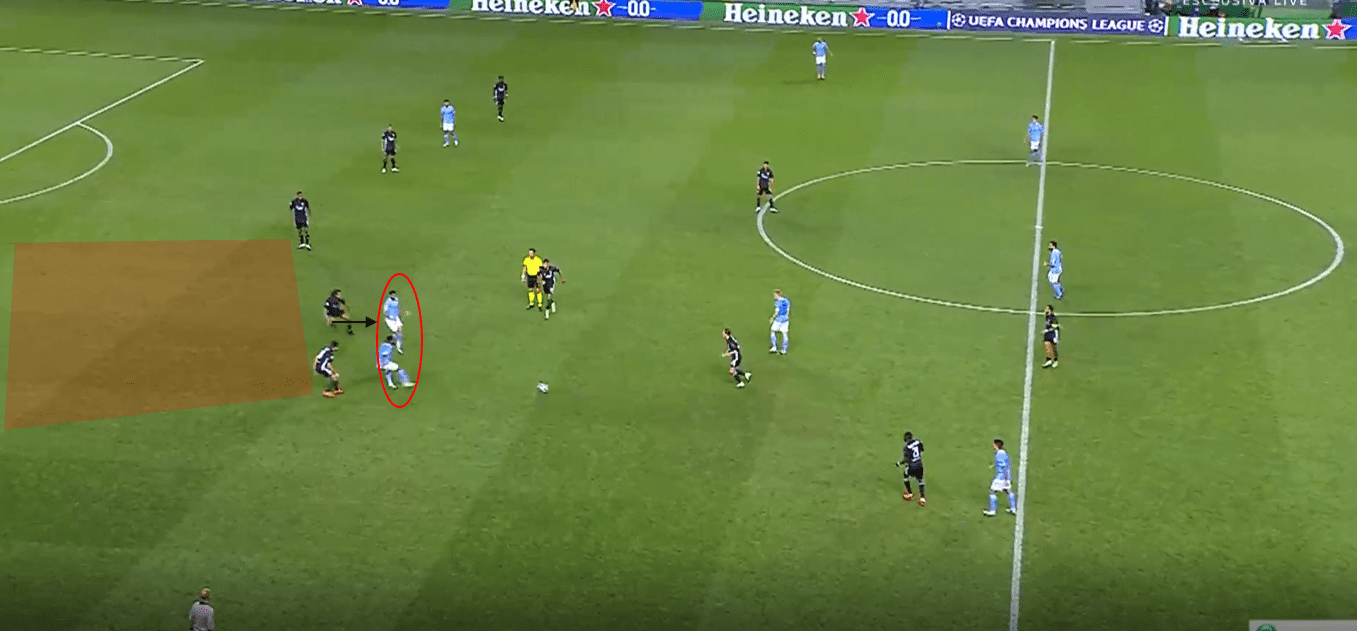
With this player occupying the centre back to move higher, Sterling can then make a movement the opposite way into the space behind the pressing centre back. Mahrez is, therefore, able to find him with a lofted ball in behind, and Sterling crosses for De Bruyne to score.
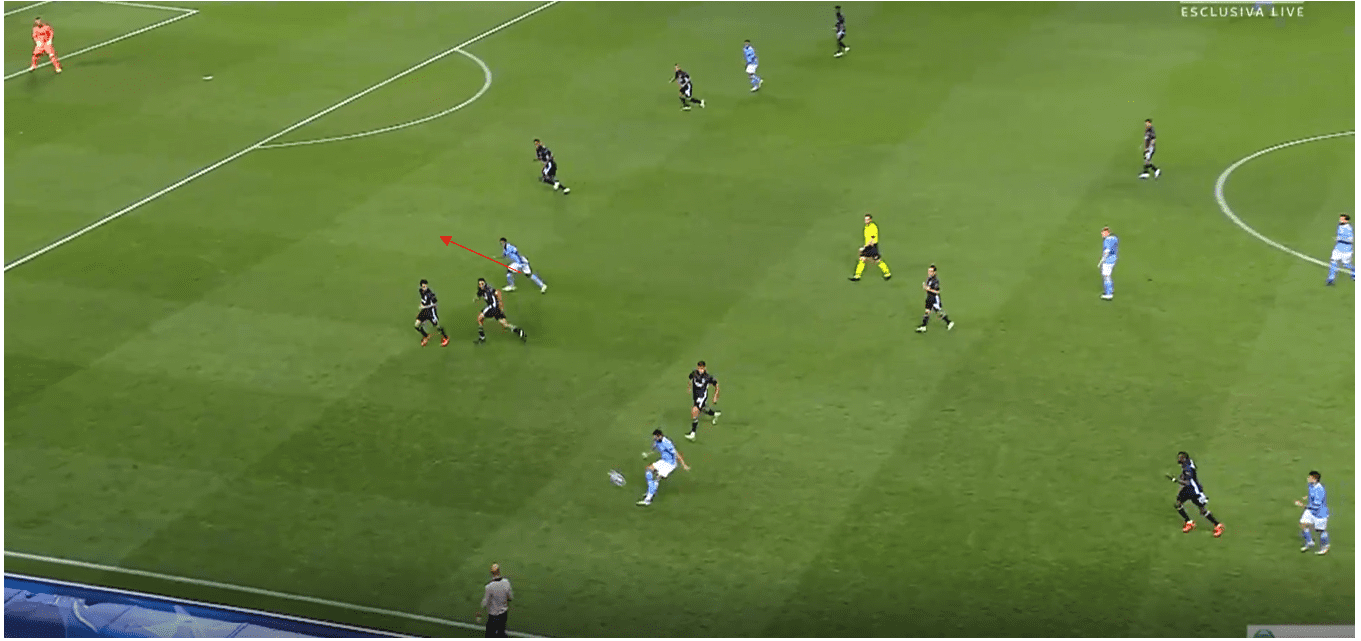
As a result, I have thought of some theoretical examples of how Bayern can use their positional play to build past Lyon. Of course, not every scene is possible in every situation, but given the right conditions, these solutions would be effective. The first is a simple backdoor cut run by the winger. In a back four, the pivot dops centrally and ensures he is covered by the pressing striker. Width is provided by the full-back, and so the half-space can open up just enough for a potential pass into Müller. Müller can then make a move towards the centre back, which will trigger his marker to follow, and Gnabry can then make a run in behind. Some more dynamism could be added by having a full-back complete this run from deep or the winger (Gnabry ) disguising the run, but this is the simplest form of the idea. Gnabry then supplies the height in the attack.
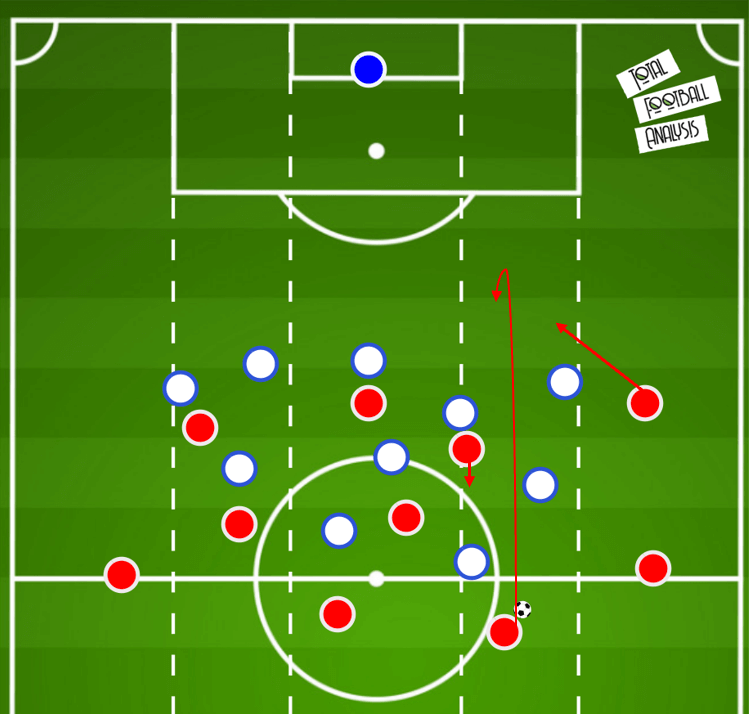
This example involves a decoy run and slight rotation to open up space for the winger to drop deeper to receive. The full-back starts wide and makes an inwards run, and a pass is played behind him for the winger to arrive into from behind. This will likely allow the wide central midfielder to be evaded and for the winger to then be pressed by the wing-back, which opens up space for all kinds of combinations in behind. The central midfielder can move forward to create an overload in the half-space, while height is still preserved in the team through the striker.
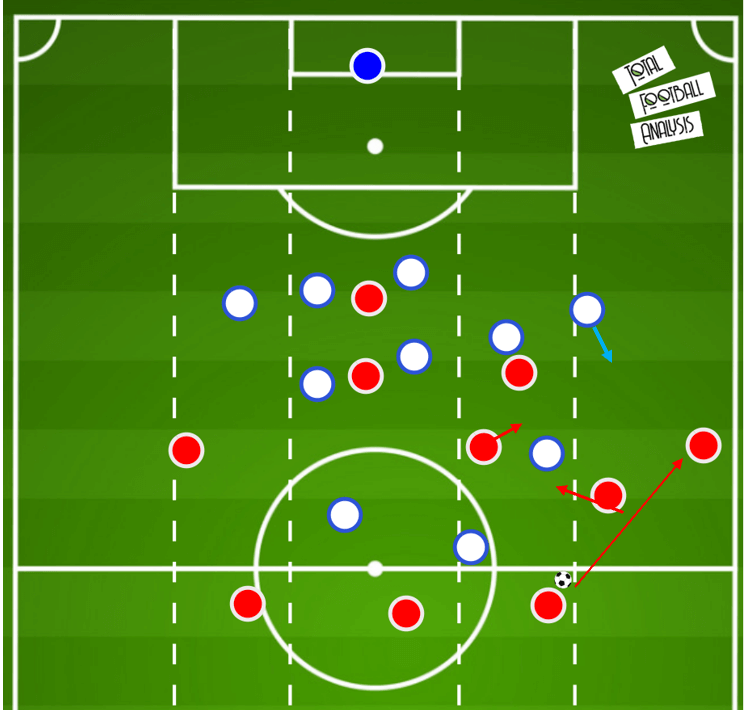
Similarly, in a back three, a press from the wide central midfielder on a wide centre back can be engaged if high enough. Bayern could then utilise the ‘double width’ concept and so can create a wide overload on the wing-back, who is unlikely to go and press while pinned back in this way. This time on the ball for either Benjamin Pavard or especially Alphonso Davies could cause some real problems for Lyon, and a number of movements from the striker or Raumdeuter could be used.
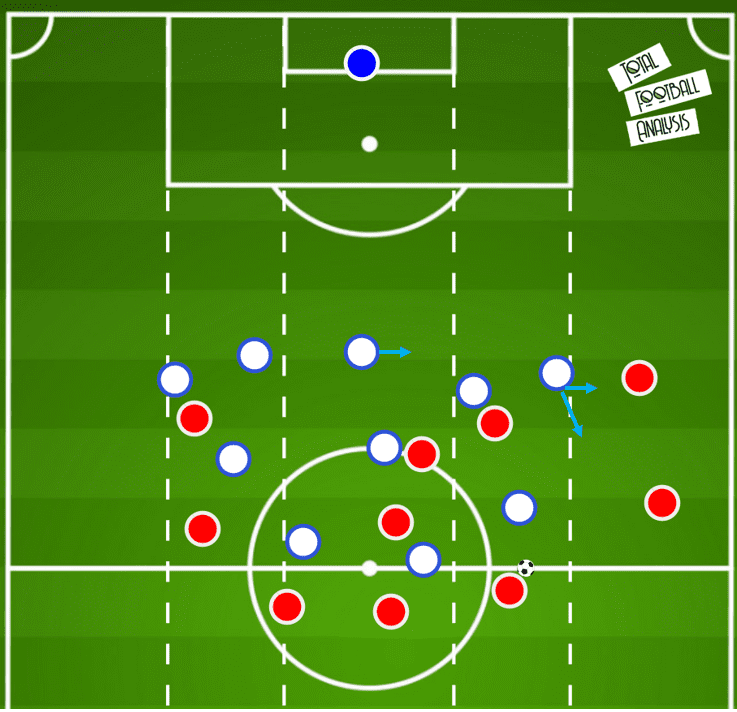
All of these examples follow the general principles of positional play previously highlighted, as well as a simplistic one regarding engaging centre backs when facing a back three- If one player moves high, the other moves deep, and vice versa. In all previous examples, we have been trying to use space in behind, but if players make decoy movements to go in behind, players should also then offer shorter passes into the space created. In this example, a back three is used again to increase access to the wing-back, and this time the half-space occupier will provide the height with a run forward. This opens up space for a diagonal pass for a player like Müller who arrives from deep or a wider angle into the space to receive. Striker Lewandowski can then make runs through on goal, for Müller to pick out with a diagonal pass. Again switching of play is important here, as if this is done too slowly Lyon’s midfield may adjust across.
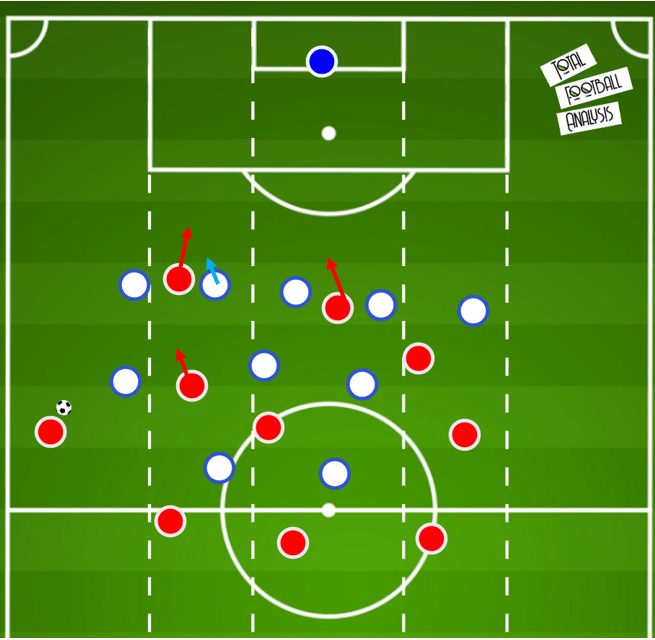
This concept could also be executed with a back four, which would allow for a central midfielder to make this run forward rather than a forward player. As a result of having more players forward, more pinning actions can occur. As an example also, we can see a movement which could be made from the third line backwards to receive, as this would add some more disguise onto the run and blindside the midfielder.
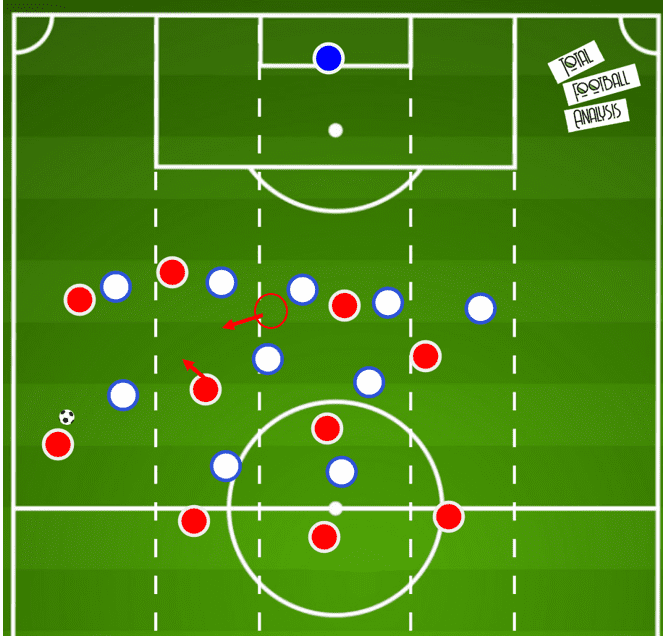
In this example the pivot can be used to provide depth to the attack, to allow for the height to be accessed by a run in behind. The half-space occupier engages a defender to press and receives the ball deep, which triggers a movement from the pivot to move out of the cover shadow of the pressings striker and receive deeper. The high striker can then make a run in behind into the space left by the pressing central defender.
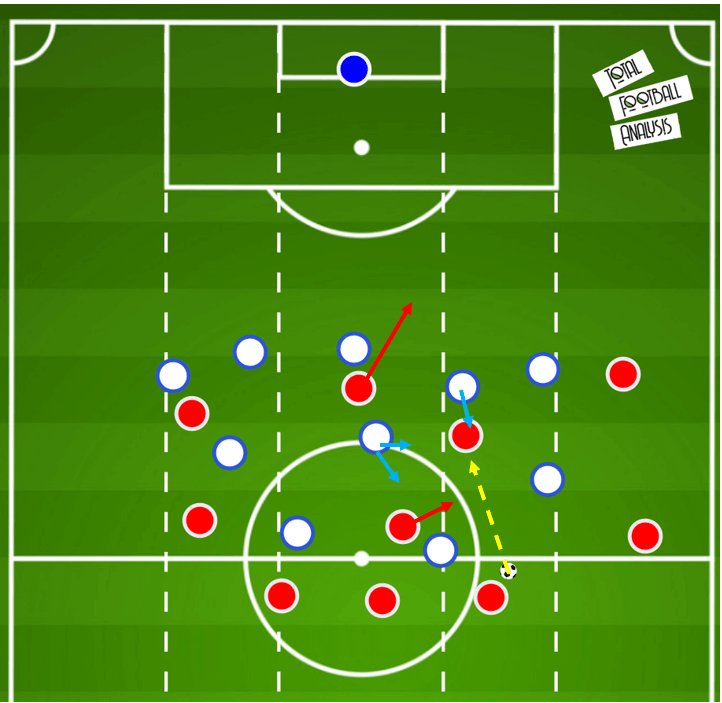
These two examples show the impact constant, fast, switching of play could have on Lyon’s defensive structure.
As mentioned previously, if the ball is switched quickly, Lyon cannot commit a central midfielder across to press the wing, and as a result, their wing-back steps forward to press. This play takes advantage of this by dragging the centre back wider and increasing the spacing between the back-line, allowing for a cute through ball through the lane between the wing-back and wide centre back. Manchester City played a pass-through this lane three times, and you can see these scenes in the notes I have put on my twitter account.
The prospect of a double pivot is also a fascinating one for Lyon, as with these constant switches of play, it is difficult for Lyon to cover one pivot continuously, let alone two. Having the double pivot in place while in a back four allows Bayern increased coverage and better outside to in possessions and so it will be interesting to see if Lyon commit a midfielder player to press higher. This would create an overload similar to what is seen in this image, and would then open up opportunities for Bayern.
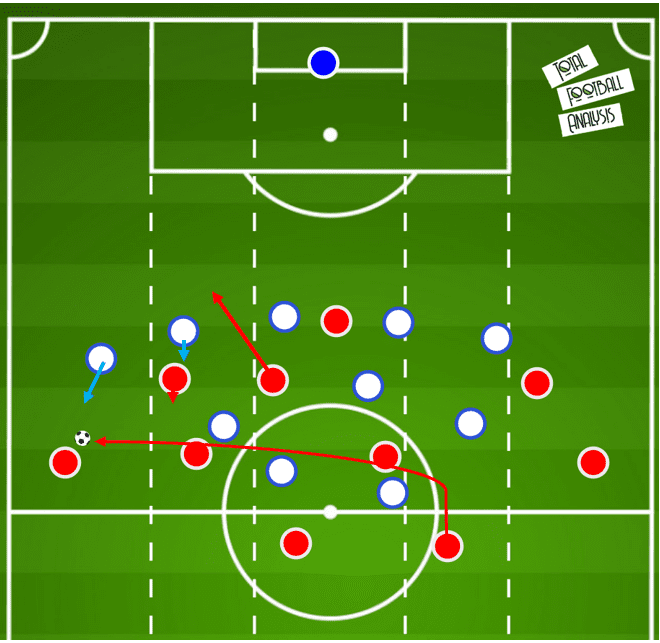
Of course, if I was coaching these ideas, they would not be laid out solely as almost set plays. Instead, the players are drilled in the principles involved in these plays, and their decision making is developed so that they themselves solve the problems creatively in-game.
Rest defence vs rest offence
While thinking of creative ways to dissect Lyon’s mid-block, it is important to consider rest defence. As a result, plays that involved a central midfielder moving forward were thought of as less desirable than other plays, as it is these midfielders which hold Bayern’s counter-pressing in place. When seeking to solve problems then, Bayern have to consider if their shape is set up to counter-press should the ball be lost, as Lyon have shown their threat on the counter.
Below we can see an example of their rest defence against Dortmund this season, with the full-back and nearest central midfielder both available to immediately counter-press vertically to prevent forward passes. Furthermore, the other central midfielder Leon Goretzka, and left full-back Alphonso Davies are also very compact, and so sideways options can be covered too.
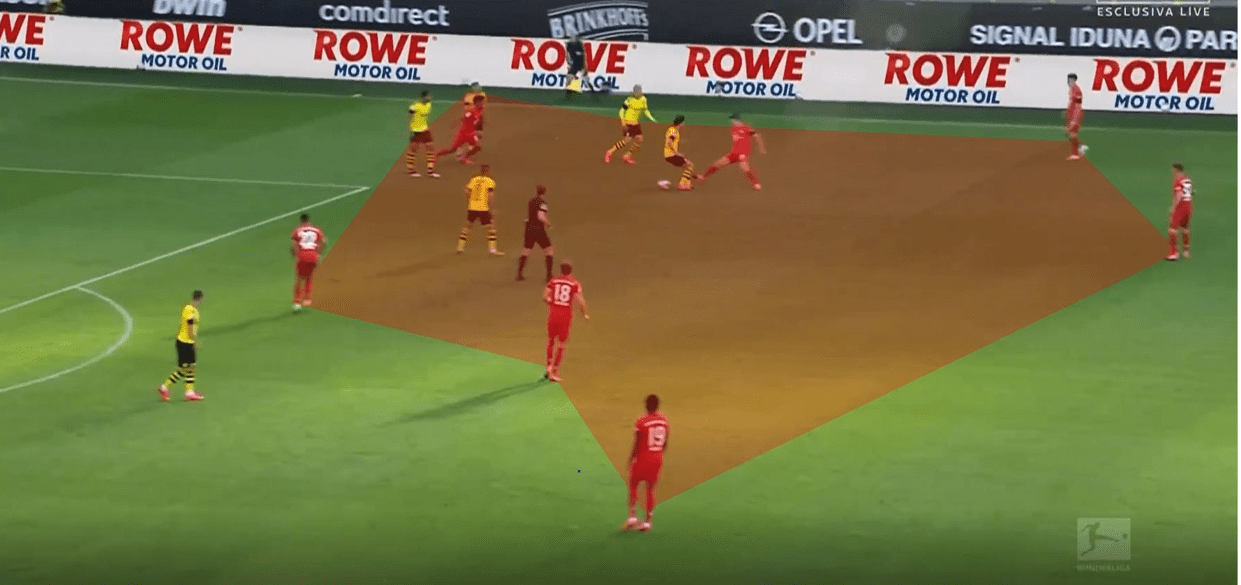
In terms of Lyon’s rest offence, most counter-attacks start with passes into their central midfielders, where if on the left Cornet will sprint down the flank immediately. We see here a lack of compactness hurts Manchester City, as a back three and one deep pivot does not bode well for counter-pressing. This lack of compactness means Lyon’s central midfielder can receive and then dribble forward and pick out a pass. Bayern, in particular, should monitor Houssem Aouar and counter-press him and the space around him immediately in a tight structure to prevent passes being played, Tactical fouls are also a part of counter-pressing.
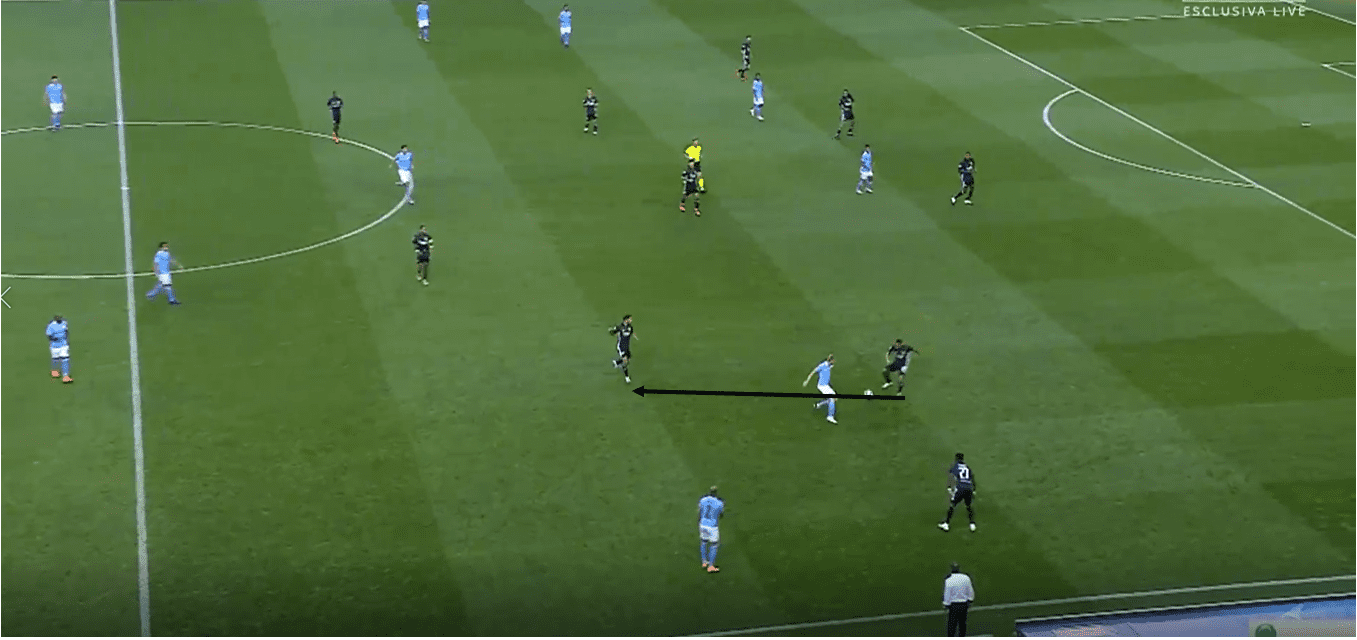
This scene combines the rest of the defence and the offence of both sides and details a fairly healthy scenario for Bayern. We see one of the pivotal players in this scene is the ten, Müller as if he commits too high then deeper Lyon midfielders may be able to receive more quickly. It is vital the Bayern central midfielder stay as compact as possible without hurting the offensive structure of the team, as Lyon’s central midfielders may make quick movements to receive and then play in behind Bayern’s high line. It is worth noting too that having a system that involves rotations and roles can make counter-pressing that bit more complex, as when deciding which role to occupy you must also consider what happens if you lose the ball. If a striker rotates to become a depth option, they may not comprehend that they cannot run forward or the rest defence is lost.
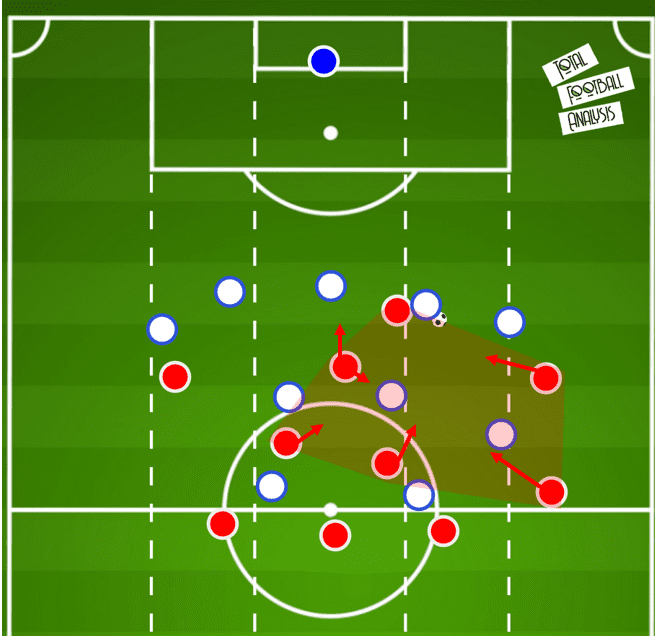
A Lyon change in the system?
To throw a possible spanner in the works, Lyon also have experience playing in a 4-1-4-1 this season, which is a formation which matches up well against a 4-2-3-1 due to its staggering. They even fell into this formation at times late on during their win over Manchester City, and so this could be a possible option if Garcia doesn’t feel confident in a five at the back system against Bayern. We can see an example of the 4-1-4-1 pressing dynamics against Manchester City below.
The lone striker would do what was possible against a back two, while the central midfielders would jump to press a dropped central midfielder if they engaged them deep enough. The winger would also press a wide centre back in this case and would cut the lane to the wing-back. The advantage of this formation is that it allowed for marking of the half-space player without the added risk of a centre back pressing, however, it reduces coverage along the back-line and in pressing moments it can be more difficult to track the half-space player, compared to a centre back, tracking them from behind.
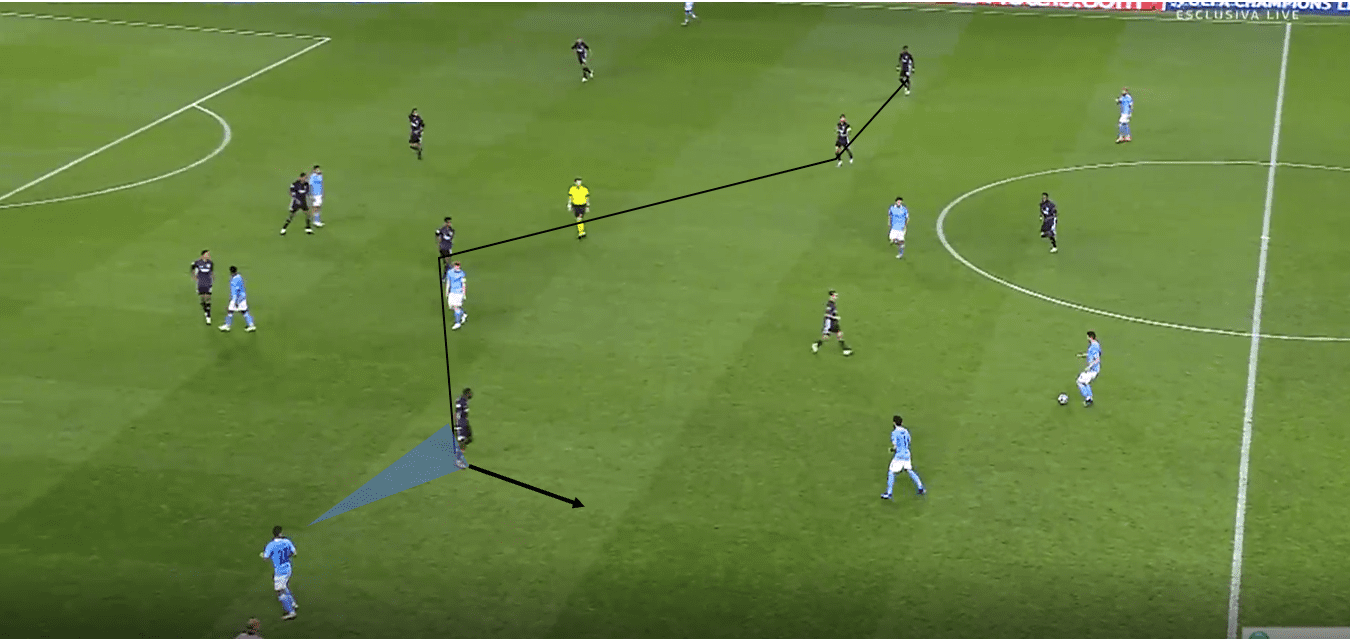
I have written in detail about the use of a 4-1-4-1 against Bayern in this analysis linked here, and to go into the same detail on this formation as I have on the 4-1-4-1 would require another 4000 words, and so I’m sure you would agree this article is long enough without adding this in also. Bayern will have prepared to face both of these formations, but I suspect that they believe a five at the back is more likely due to Lyon’s previous successes.
Conclusion
Overall, Lyon presents an interesting opponent to Bayern and have proved themselves to be a problem for top-quality opposition. They present a fairly obvious problem to Bayern that can be solved with difficult solutions, and so as with any game of football generally, it will come down to Bayern’s ability to provide those solutions. They have the tactical ability, as well as elite technical players and decision-makers, but they will have to be patient and mature against a tricky Lyon side, as one slip in that rest defence could send them out the competition.




Comments